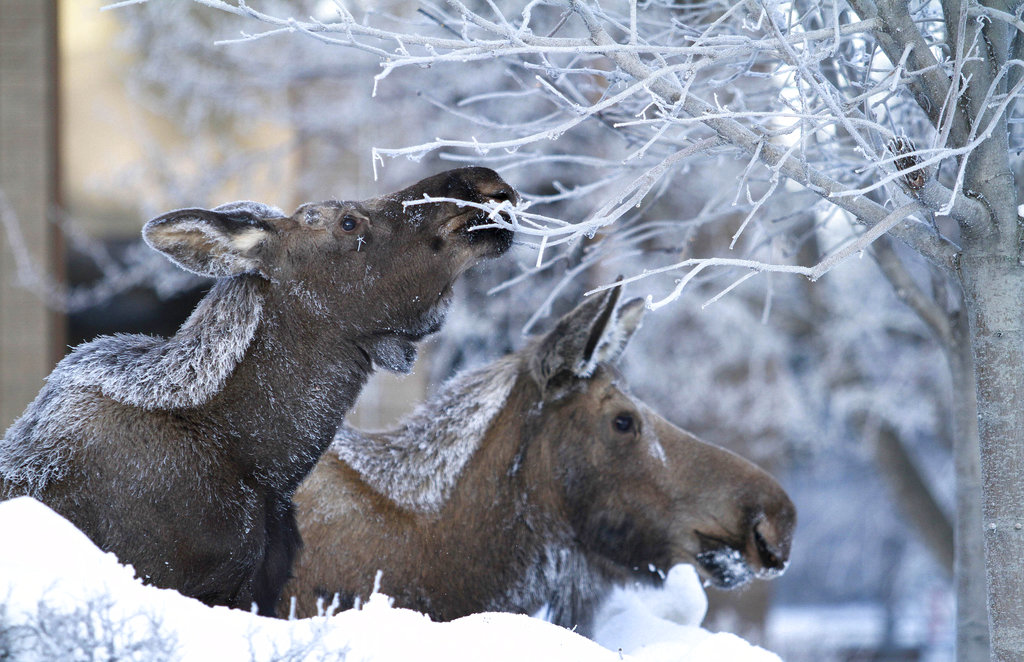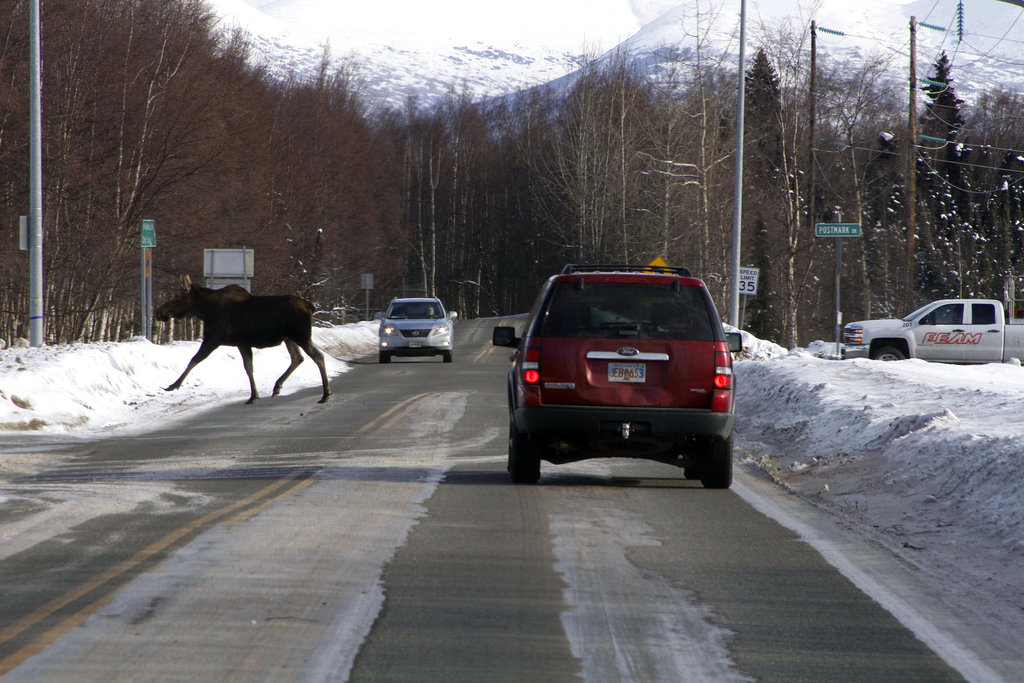Biologists turn to citizens, DNA to count urban Alaska moose

In this March 8, 2012 file photo, a calf moose and its mother browse on frosted branches of ornamental trees in the parking lot of the Boney Courthouse in Anchorage, Alaska. Image: Dan Joling / AP
ANCHORAGE, Alaska (AP) — Moose thrive in Alaska’s largest city with little to fear from natural predators such as wolves or bears, but getting an accurate count of the largest member of the deer family remains a challenge for the state wildlife biologists who must manage their numbers.
Traditionally, aerial surveys are performed from low-flying aircraft after there’s snow on the ground when spotters can distinguish between male moose with antlers and cows without them, but flight rules from Anchorage’s international airport prohibit the survey flights.
In response to those restrictions, the Alaska Department of Fish and Game is experimenting with a new method of surveying moose. Biologists for three days last month asked Anchorage residents to call or text whenever they spotted moose. Teams of moose trackers with dart guns then hurried to the locations. The darts they fired captured DNA samples.
DNA analysis will let researchers calculate the ratio of bulls to cows. The samples also will be the start of a database to identify individual moose, without the expense of capturing them.
“Think of it as building a family tree,” said Sean Farley, a state research biologist.
While other U.S. cities get overrun with deer raiding gardens, Anchorage residents are used to steering clear of moose because hitting them with a car can be fatal to both animal and driver. Bulls weighing up to 1,600 pounds (726 kilograms) are dangerous during the fall rut and cows will attack people if they get close to calves. Moose use their hooves to stomp on people or dogs if cornered.
Anchorage spans 1,963 square miles (5,080 square kilometers), an area the size of the U.S. state of Delaware. The city has 300,000 people, but the moose population is unknown. Though hunting is not allowed in most of the city, biologists want to know how many moose move in and out of hunting areas.

File – In this March 1, 2017 file photo, a moose crosses a road near the Ted Stevens Anchorage International Airport in Anchorage, Alaska. Image: Mark Thiessen / AP
“We’ve been taking an educated guess,” said area biologist Dave Battle. “There’s really been no technique up until now and it’s something we’ve been kind of beating our heads against the wall for the last couple of years about it.”
Battle was among teams collecting DNA. After receiving a call reporting a moose cow and her calf, he found them in the yard of a home foraging for twigs.
He fired weighted, pencil-length darts into the sides of both moose, which were startled and moved a few feet before resuming feeding. The darts felt like bee sting, researchers said.
A skin sample wraps around a needle in the tip of the darts, which have heavy barrels to make them fall into the snow.
Surveys suggest most Anchorage residents like sharing their yards with moose. Biologists said their participation in the survey is crucial, and the department received 510 calls and texts over the three-day moose reporting period for residents.
“That’s what’s going to make or break this study,” said David Saalfeld, another state biologist. “Public involvement.”
Biologists traditionally estimate wildlife abundance with the “mark-recapture” method of capturing and tagging or collaring animals and then allowing them to remix with the general population.
Populations are sampled later and abundance estimates are made based on the count of marked animals.
Farley said the current survey is a research project but he’s optimistic it could help biologists estimate Anchorage’s moose population.
At worst, the three-days of DNA sampling will be the basis for a future mark-recapture study of Anchorage moose.
“If the math works, and again, that’s relying on people who are a lot brighter than me, then yes, in the first year, you could come up with a measure of abundance,” he said. AB
RELATED STORIES:
China plans panda park that will dwarf Yellowstone
Last male northern white rhino takes a walk despite illness
Mexican troops partner with activists to save vaquita porpoise